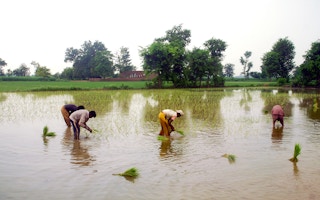I recently came across some real news about Pakistan which merits sharing, and commenting. According to a July, 2017 article by Carole Dalin at University College, London and fellow authors, in Nature, the world’s top journal for scientific knowledge, Pakistan is the largest exporter of depleted groundwater embedded in agricultural exports in the world. We account for 29 per cent of the global trade in agricultural products grown from over abstraction of groundwater, ahead of the United States (27 per cent) and India (12 per cent). So we are number one in something, should we be happy and proud that we even beat the United States, let alone India? Or is there a cause for concern?
The research presented by Dalinet al. is predicated upon the concept of virtual water coined by my esteemed colleague, Professor Tony Allan, at King’s College, London. The concept is simply that all agricultural, or for that matter any industrial products require a certain amount of water to produce, which is embedded in those products as virtual water. For example, it takes about 22,000 litres of water to produce one kilogram of beef, 1,350 litres for one kilogram of wheat, 3,000 litres for a kilogram of rice, 140 litres for a cup of coffee etc. As a water researcher, I have my reservations about the concept and its use, which are beside the point. One has to concede that it is an amazing teaching devise for drawing attention to the impact on water resources, for producing goods and services, particularly agricultural products that make our life styles possible.
So what does it mean that Pakistan is the largest exporter of depleted groundwater as virtual water through its agricultural exports? In Pakistan, up to 80 per cent of the water required by crops to grow comes from groundwater, and not from surface water, as is commonly believed. In fresh groundwater zones, most of the water is in fact, surface water that seeps through canals into groundwater, that is pumped back up to the surface for agriculture. Groundwater extraction rates in Pakistan are much beyond the natural recharge rates, at which the groundwater is replenished.
In the upper Indus we extract 54 per cent more water than can be naturally replaced in the aquifer and by 18 per cent in the lower Indus. This over extraction of water Dalinet al. demonstrate is mostly used to grow wheat, rice, cotton and other crops such as sugarcane, respectively. The water therefore is virtually embedded in these crops. Almost all of our virtual water exports are in the form of rice (82 per cent) to four main countries, Iran, Saudi Arabia, Kenya and Bangladesh. To put it simply, we are living beyond our (water) means to grow rice among others, not for ourselves, but to sell to other countries.
“
[Farmers] do not have the resources to pay for the equipment or the electricity for deep tubewells to get to ever receding groundwater, thereby leading to increasing rural poverty.
So, is that a good thing? The answer depends on one’s perspective. If one is a free market and free trade enthusiast, one can argue that the benefits we gain in terms of foreign exchange and revenue for the agricultural sector outweigh the cost of drawing down the groundwater. The things we are able to import, with the dollars we earn from our agricultural exports, give us the means to pursue other developmental ends including poverty alleviation.
If one is from an environmental sustainability or social equity perspective it is a very bad thing. From an equity standpoint, the costs of lowering groundwater are overwhelmingly borne by the poor and small farmers. They do not have the resources to pay for the equipment or the electricity for deep tubewells to get to ever receding groundwater, thereby leading to increasing rural poverty. In the long run, everyone pays a price as springs and wetlands dry up, and groundwater resources get dangerously low. It is no coincidence that Pakistan has the highest urbanisation rates in Asia. Poor farmers unable to compete in the race to the bottom—literally—are abandoning farms and heading to the cities, putting the urban infrastructure under unprecedented stress.
Is there an absolute scarcity of water in Pakistan? How can the largest exporter of virtual water protest water scarcity? The answer simply is that there is no absolute water scarcity. It is socially constructed, and large farmers engaged in agricultural exports are the culprits and the beneficiaries of it. There are only three types of water storage: glaciers, surface (dams) and groundwater. We have one of the largest reserves of groundwater in the world, and we misuse it for the benefit of commercial interests. The Chinese when they prioritise agricultural investments under the Chinese Pakistan Economic Corridor (CPEC) are not looking for land. They have plenty of it. They want our water. We would do well to remember that in this season of hollering about conspiracies and attacks on democracy.
This article was first published in the Daily Times. Daanish Mustafa is a reader in Politics and Environment at the Department of Geography, King’s College, London. This post is republished from thethirdpole.net.











